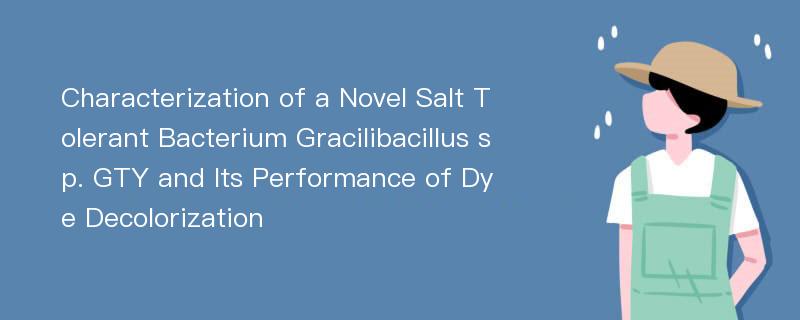
论文摘要
The main aim of this research work was to decolorize various azo dyes and reactive dyes from lab-scale dye solutions and real textile wastewater samples under high salt concentration conditions. Decolorization experiments were run using a recently isolated halophilic bacterium Gracilibacillus sp. GTY. As a new bacterial strain, some other investigations, such as isolation, characterization and study of a large extrachromosomal DNA were also taken place. So the dissertation is presented in different steps bellow.Firstly, a highly salt tolerant strain obtained from Dalian coastline, was identified as Gracilibacillus sp. GTY on the basis of morphological and physio-biochemical characteristics and 16S rDNA sequence analysis. According to DNA sequence, the maximum 93%-95% homology was found for the strain GTY. The strain was deposited as a patent strain in China General Microorganism Culture Center with the accession number CGMCC 1527. The 16S rDNA sequence of GTY was also submitted to GenBank with the number DQ 286727. The strain was gram-negative, rod-shaped and strictly aerobic. Optimum growth conditions were observed: temperature±30℃, pH 7.2, 10%-15% (w/v) of NaCl, and proline as the best compatible solute as well as a good carbon source. The rapid and smooth growth rates were observed in 10%-15% (w/v) of NaCl supplemented Luria-Bertani (LB) and Mineral-Salt (MS) media, but the strain could survive narrowly in the media containing up to 25% (w/v) of NaCl. So it was considered as a highly salt tolerant strain. Secondly, a large molecule of extrachromosomal DNA was isolated from the strain by a modified method. Then this plasmid DNA was eliminated by acridine orange to know its role in host genome. After successful elimination, it was assumed that the plasmid contains some key genes, which may be responsible for the bacterial salt tolerance.Thirdly, an attempt was made to optimize conditions for the bacterial decolorization of various dyes in lab-scale dye solutions under high salinity conditions. Decolorization experiments were conducted by growing and resting cells as well as azo reductase. Experiments were performed under different concentrations of NaCl. Detailed analytical investigations were performed using only one of the azo dyes, Acid Red B. For growing cells, strain grown in media containing10%-15% (w/v) of NaCl showed the best performance of azo dye Acid Red B decolorization. Dye was almost completely decolorized (nearly 100%) after 96 h of treatment. Strain grown in the media containing 2%-5% (w/v) of NaCl showed very poor decolorization ability where bacterial growth rates were very poor also. On the other hand, strain grown in the media with the highest percentage (25%, w/v) of NaCl showed moderate decolorization ability. Strain grown in lower percentages of NaCl could not show good performance of decolorization because of low growth rates. Decolorization was not satisfactory also in the media containing 25% (w/v) of NaCl, because the inhibition to microorganisms by high salt concentration, which may cause plasmolysis and /or loss of activity of cells. Resting cells also showed the best performance of decolorization in 10%-15% (w/v) of NaCl. Extracted azo reductase was non-purified and non-characterized. The decolorization of dye was conducted in 3 ml of reaction mixture at 30°C in 700 sec. Reaction rate obtained from time course spectra measurement analysis was comparatively slow. The percentage of dye removal was about 10% in the reaction mixture.Finally, several experiments were set up to degrade a textile azo dye Acid Red B and remove COD from a real textile wastewater body. The textile wastewater sample was naturally salty (10% of Na2SO4), and COD value was relatively high. The textile wastewater sample was used by adding certain nutrients and NaCl for the proper growth of this salt tolerant strain. The study was conducted on the basis of various environmental factors and substrates. Dye degradation and COD removal rates were comparatively slow in first two days. Decolorization efficiency might be attributed to the microbial shock due to the change of environment and the possible toxic or inhibitory effects of certain compounds of the textile wastewater on the microbe. Nevertheless, after an acclimatization period of 6-10 days, the anaerobic microbes retained their activity leading to wastewater’s decolorization efficiency of nearly 96% in optimum growth condition. Then COD removal rate was also satisfied. After decolorization, COD removal was observed 4436.87 (mg/l) where the initial COD value was more than 7000 (mg/l).
